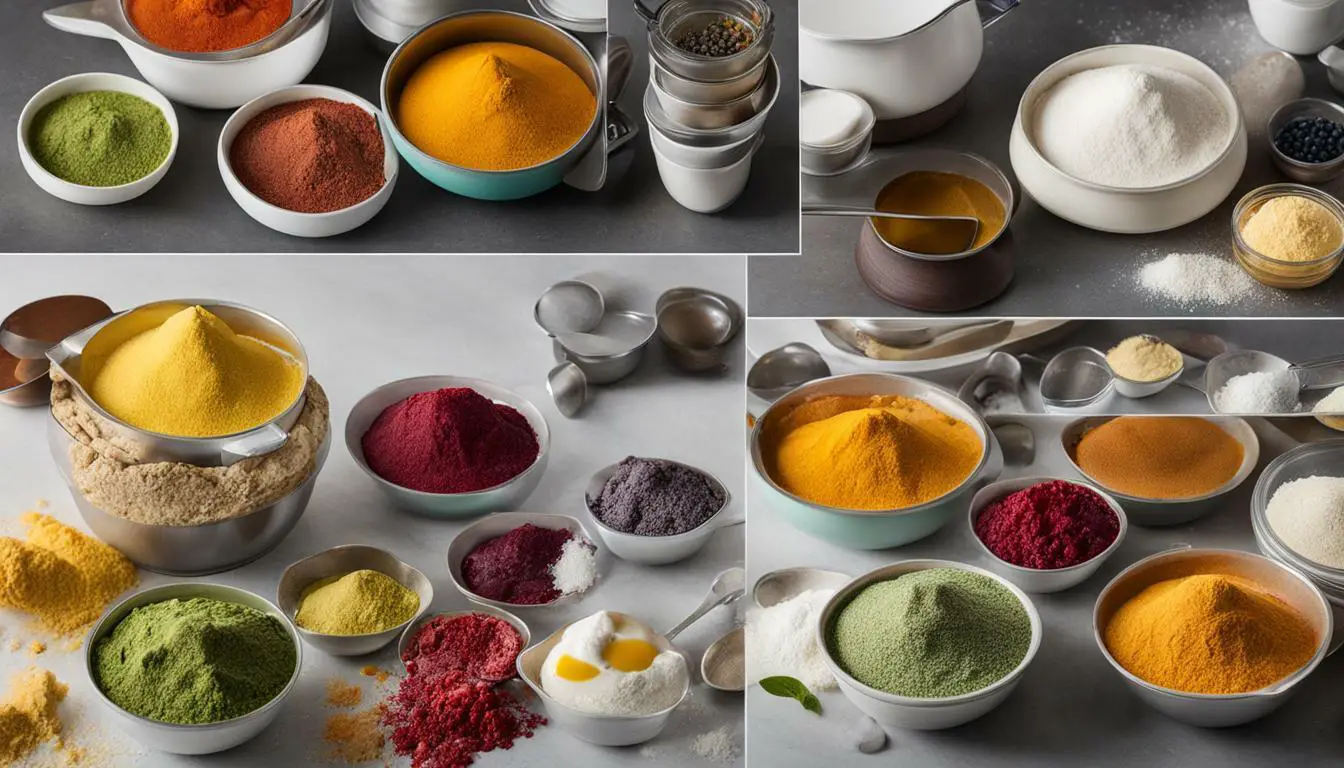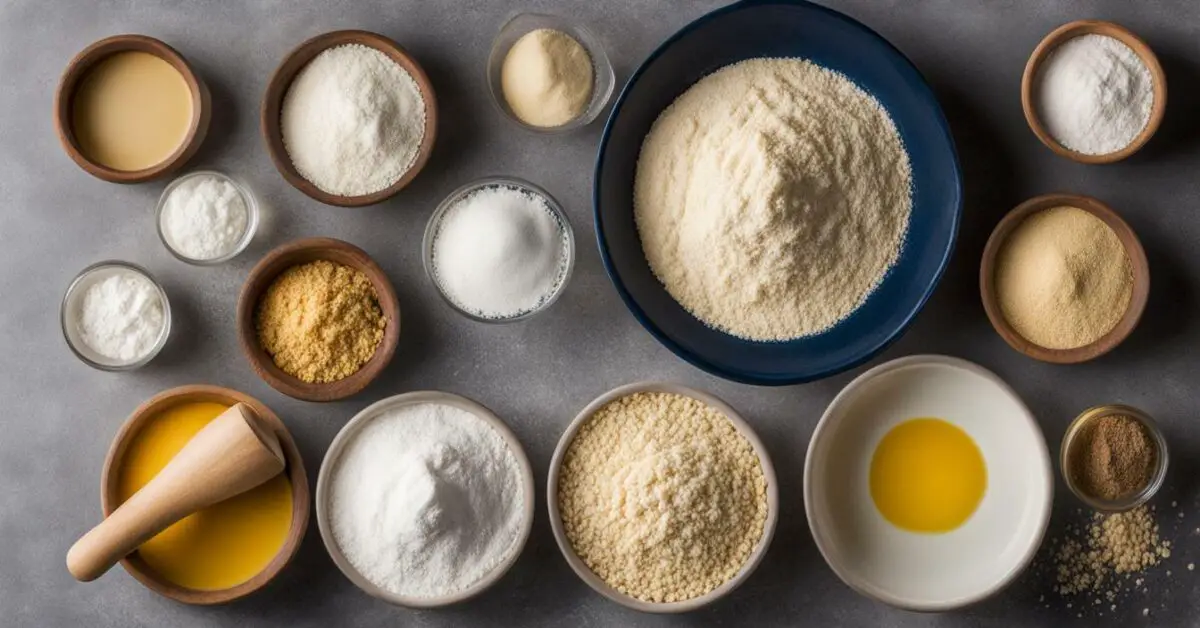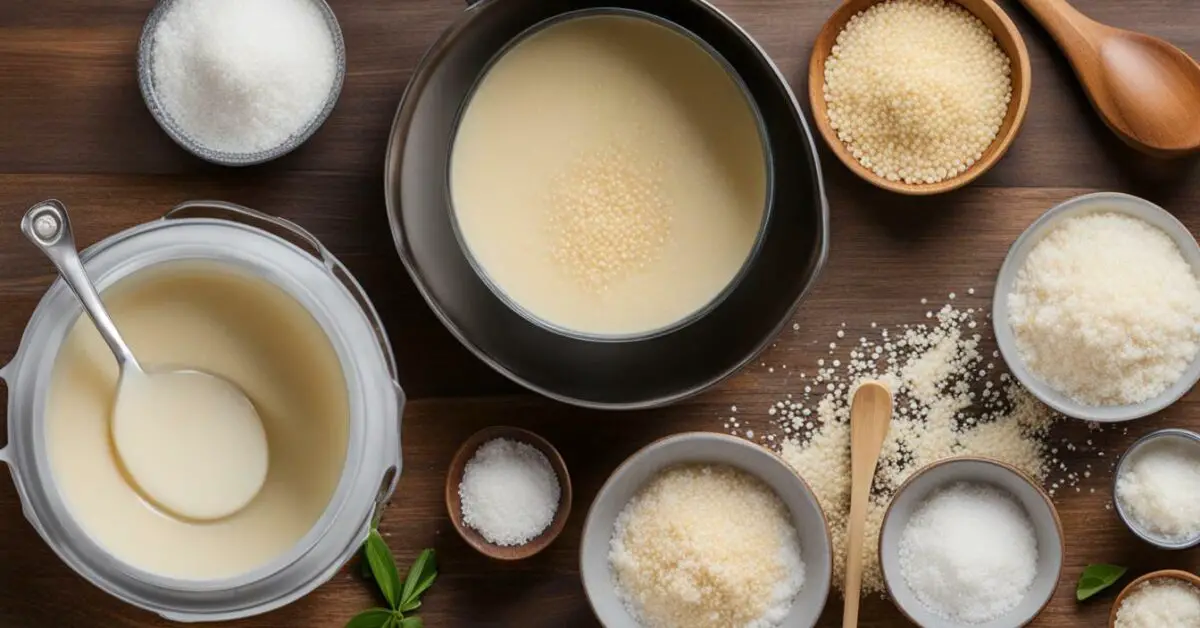
This post may contain affiliate links. Please read my disclosure for more information.
Are you looking for the best substitutes for cornstarch in thickening? Here are the top 10 options to help you achieve the perfect consistency in your recipes.
Key Takeaways:
- Potato starch can be used as a one-to-one replacement for cornstarch in all applications.
- Rice flour works well for creating a crispy coating in fried foods, but may result in a grittier texture when used as a thickening agent.
- All-purpose flour is a common thickener that can be used in roux or sauces, but will result in a thicker and opaque texture compared to cornstarch.
- Tapioca flour is a good substitute for cornstarch in puddings and sweet sauces, but should be used in moderation to avoid a gummy texture.
- Arrowroot powder can be used as a substitute for cornstarch, but it doesn’t hold up well to heat and is best used in recipes that don’t require direct heat or long simmering.
Potato Starch: A Versatile Substitute for Cornstarch in Thickening
Potato starch is an excellent alternative to cornstarch when it comes to thickening your dishes. Whether you’re making sauces, soups, or gravies, potato starch can be used as a one-to-one replacement, making it a versatile option for various recipes.
One of the advantages of using potato starch is its neutral flavor, which allows the other ingredients in your dish to shine. It also has a smooth texture that blends easily into your recipes, resulting in a silky and thick consistency.
When using potato starch as a substitute, simply replace the amount of cornstarch called for in the recipe with the same amount of potato starch. This ensures that you achieve the desired thickness without compromising the overall taste and texture of your dish.
To give you a better idea of the differences between cornstarch and potato starch, here’s a comparison table:
| Thickener | Texture | Taste |
|---|---|---|
| Cornstarch | Smooth and glossy | Neutral |
| Potato Starch | Silky and thick | Neutral |
As you can see, potato starch offers a similar texture and taste profile to cornstarch, making it an ideal alternative in your culinary endeavors. So the next time you run out of cornstarch, don’t worry—potato starch has got you covered!
Rice Flour: A Crispy Substitute for Cornstarch in Thickening
When looking for a substitute for cornstarch in thickening, consider using rice flour for a crispy texture in your fried recipes. Rice flour is a versatile option that can add a unique crunch to your dishes. It is commonly used as a coating for fried foods, providing a deliciously light and crispy texture.
However, it’s important to note that rice flour may result in a grittier texture when used as a thickening agent in sauces and gravies. While it can still provide some thickening properties, it’s best suited for recipes where the main goal is achieving a crispy coating rather than a smooth and silky consistency.
If you’re experimenting with rice flour as a substitute for cornstarch, it’s recommended to start with a small amount and gradually increase as needed. This will help you maintain control over the texture of your dish and ensure the desired results.
| Rice Flour as a Substitute for Cornstarch | Texture | Usage |
|---|---|---|
| Fried Foods | Crispy | Coating for fried foods |
| Sauces and Gravies | Gritty | Use in moderation, may not provide smooth texture |
While rice flour may not be a perfect replacement for cornstarch in all applications, it can add a unique and enjoyable texture to your fried recipes. Experiment with different ratios and combinations to find the perfect balance of crispiness and consistency in your dishes.
All-Purpose Flour: A Reliable Substitute for Cornstarch in Thickening
If you don’t have cornstarch on hand, all-purpose flour can be a reliable substitute for thickening your culinary creations. This common kitchen ingredient is versatile and readily available, making it a convenient alternative for thickening sauces, gravies, and other dishes. While it may result in a thicker and opaque texture compared to cornstarch, with the right adjustments, you can achieve the desired consistency for your recipes.
When using all-purpose flour as a substitute, it is essential to create a roux or slurry to incorporate it smoothly into your dish. To make a roux, simply melt butter in a pan and gradually whisk in the flour until it forms a smooth paste. Cook the roux for a few minutes to remove any raw flour taste before adding it to your recipe. For a slurry, whisk equal parts flour and water until well combined, then gradually add it to your sauce or gravy, stirring constantly until thickened.
It is important to note that the amount of all-purpose flour needed may vary compared to cornstarch. Start with a smaller amount and gradually add more as needed to avoid over-thickening your dish. Remember that all-purpose flour may take longer to thicken compared to cornstarch, so be patient and allow enough cooking time for the flour to fully activate its thickening properties.
| All-Purpose Flour | Cornstarch |
|---|---|
| Thicker and opaque texture | Light and transparent texture |
| Requires roux or slurry | Can be added directly to recipes |
| Start with smaller amounts and gradually add more | Typically used in a 1:1 ratio with cornstarch |
Experimenting with all-purpose flour as a substitute for cornstarch can open up new possibilities in your cooking. It is a versatile thickening agent that adds depth and richness to your sauces and gravies. So, the next time you find yourself without cornstarch, reach for the all-purpose flour and elevate your culinary creations.
Tapioca Flour: A Great Alternative to Cornstarch in Thickening Sweet Recipes
When thickening sweet recipes like puddings and sauces, tapioca flour can be a great alternative to cornstarch. It is a gluten-free thickener that can create a smooth and velvety texture in your desserts. Tapioca flour is derived from the cassava root and is known for its ability to thicken without adding a starchy taste to your dishes.
One of the advantages of tapioca flour as a substitute for cornstarch is its ability to hold up well in high temperatures. This makes it suitable for thickening sauces and fillings that require baking or boiling. Additionally, tapioca flour has a neutral flavor, allowing the natural sweetness of your desserts to shine through without any overpowering taste.
To use tapioca flour as a thickener, you can mix it with a small amount of water to form a slurry before adding it to your recipe. This helps to prevent lumps and ensures even distribution throughout the dish. It’s important to note that tapioca flour has a stronger thickening power compared to cornstarch, so you may need to adjust the quantity accordingly.
| Tapioca Flour | Cornstarch |
|---|---|
| Gluten-free | Contains gluten |
| Neutral flavor | Mild starchy taste |
| Thickens at high temperatures | May break down at high temperatures |
In summary, tapioca flour is a versatile and effective substitute for cornstarch when it comes to thickening sweet recipes. Its gluten-free nature and neutral flavor make it suitable for a variety of dietary preferences, while its ability to withstand high temperatures ensures successful results in baked goods and cooked sauces. Remember to adjust the quantity and follow the suggested methods for achieving the desired consistency in your dishes.
Arrowroot Powder: A Suitable Substitute for Cornstarch in Thickening
For recipes that don’t involve high heat, arrowroot powder can be a suitable replacement for cornstarch in thickening. Derived from the tropical arrowroot plant, this white, powdery substance is known for its ability to create smooth and glossy sauces, gravies, and desserts.
Arrowroot powder has a neutral taste and is gluten-free, making it a popular choice for those with dietary restrictions. It is also easy to digest and gentle on the stomach. However, it’s important to note that arrowroot powder doesn’t hold up well to heat and should be used in recipes that don’t require direct heat or long simmering.
To use arrowroot powder as a substitute for cornstarch in thickening, start by whisking it with a small amount of cold water to create a slurry. Then, gradually add the slurry to your hot liquid while stirring constantly. As the mixture heats up, the arrowroot powder will thicken the liquid, providing a smooth and velvety texture.
When substituting arrowroot powder for cornstarch, keep in mind that it has a higher thickening power. This means you’ll need to use a smaller amount of arrowroot powder compared to cornstarch. Start with half the amount of cornstarch called for in the recipe and adjust accordingly to achieve the desired consistency.
In summary, arrowroot powder can be a suitable substitute for cornstarch in thickening, especially when used in recipes that don’t require high heat. Its ability to create smooth and glossy sauces, gravies, and desserts, along with its gluten-free properties, makes it a versatile option for those looking to experiment with different thickening agents in their culinary creations.
| Cornstarch Substitute | Best Used For | Considerations |
|---|---|---|
| Potato Starch | All applications | Can be used as a one-to-one replacement |
| Rice Flour | Crispy coating in fried foods | May result in a grittier texture as a thickening agent |
| All-Purpose Flour | Roux or sauces | Results in a thicker and opaque texture |
| Tapioca Flour | Puddings and sweet sauces | Use in moderation to avoid a gummy texture |
| Arrowroot Powder | Recipes without high heat | Doesn’t hold up well to heat and long simmering |
| Xanthan Gum | Gluten-free baking | May not be readily available in every kitchen |
| Instant Pudding Mix | Sweet alternatives | Specific to sweet dishes |
Conclusion
In conclusion, there are various substitutes for cornstarch in thickening that can cater to different culinary needs and preferences. When you run out of cornstarch, you can turn to potato starch as a versatile replacement that works well in all applications. Rice flour is another option, ideal for creating a crispy coating in fried foods, although it may result in a slightly grittier texture when used as a thickening agent.
All-purpose flour is a common choice for thickening, especially in roux or sauces, but it will yield a thicker and opaque texture compared to cornstarch. For puddings and sweet sauces, tapioca flour can be used as a suitable substitute, although it is important to use it in moderation to avoid a gummy consistency.
While arrowroot powder can be used as a thickening substitute, it is not recommended for recipes that involve direct heat or long simmering. Xanthan gum, commonly used in gluten-free baking, can also serve as a thickening agent, but may not be readily available in every kitchen. Additionally, instant pudding mix can be a sweet alternative for thickening in certain recipes.
With these alternatives, you can confidently experiment in the kitchen and find the perfect substitute for cornstarch to achieve the desired consistency in your culinary creations.
FAQ
What are the best substitutes for cornstarch in thickening?
Some of the best substitutes for cornstarch in thickening include potato starch, rice flour, all-purpose flour, tapioca flour, arrowroot powder, xanthan gum, and instant pudding mix.
Can I use potato starch as a substitute for cornstarch in thickening?
Yes, potato starch can be used as a one-to-one replacement for cornstarch in all applications.
Does rice flour work well as a substitute for cornstarch in thickening?
Rice flour can be used as a substitute for cornstarch in creating a crispy coating in fried foods, but it may result in a grittier texture when used as a thickening agent in sauces and gravies.
Can I use all-purpose flour as a substitute for cornstarch in thickening?
Yes, all-purpose flour can be used as a common thickener in roux or sauces. However, it will result in a thicker and opaque texture compared to cornstarch, so adjust the quantity accordingly.
Is tapioca flour a good substitute for cornstarch in thickening?
Tapioca flour is a suitable substitute for cornstarch in puddings and sweet sauces. However, it should be used in moderation to avoid a gummy texture in your final dish.
Can I use arrowroot powder as a substitute for cornstarch in thickening?
Yes, arrowroot powder can be used as a substitute for cornstarch in thickening recipes. However, it doesn’t hold up well to heat and should be used in recipes that don’t require direct heat or long simmering.
Are there any other substitutes for cornstarch in thickening?
Other substitutes for cornstarch in thickening include xanthan gum, which is commonly used in gluten-free baking, and instant pudding mix, which can be used as a sweet alternative for thickening.


